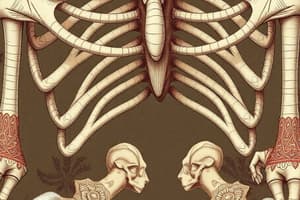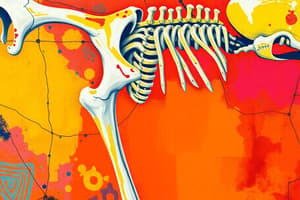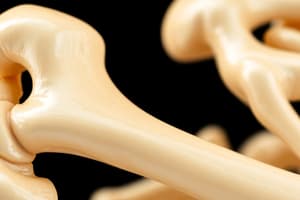Podcast
Questions and Answers
What is the primary organic component of the extracellular matrix (ECM) of bone?
What is the primary organic component of the extracellular matrix (ECM) of bone?
- Hydroxyapatite
- Collagen (correct)
- Glycoproteins
- Proteoglycans
What function does hydroxyapatite serve in the extracellular matrix (ECM) of bone?
What function does hydroxyapatite serve in the extracellular matrix (ECM) of bone?
- Facilitates cell communication
- Resists twisting and stretching
- Harden the matrix (correct)
- Provides flexibility
Which structure is the structural unit of compact bone?
Which structure is the structural unit of compact bone?
- Lacunae
- Canaliculi
- Osteon (correct)
- Central canal
What is the role of canaliculi in bone tissue?
What is the role of canaliculi in bone tissue?
What characterizes the concentric lamellae within an osteon?
What characterizes the concentric lamellae within an osteon?
What covers the expanded ends of long bones?
What covers the expanded ends of long bones?
What is the structure that forms the long axis of a long bone?
What is the structure that forms the long axis of a long bone?
What remains as a remnant of the epiphyseal plate in a long bone?
What remains as a remnant of the epiphyseal plate in a long bone?
Which type of bone marrow is responsible for hematopoiesis?
Which type of bone marrow is responsible for hematopoiesis?
Which structure lines the inner surfaces of bones?
Which structure lines the inner surfaces of bones?
How many nutrient arteries typically enter a long bone?
How many nutrient arteries typically enter a long bone?
What does yellow bone marrow primarily consist of?
What does yellow bone marrow primarily consist of?
Which of the following is true about bone tissue?
Which of the following is true about bone tissue?
What are the primary types of osseous tissue found in bones?
What are the primary types of osseous tissue found in bones?
Which of the following connective tissues is NOT a component of the skeletal system?
Which of the following connective tissues is NOT a component of the skeletal system?
How do spongy bone and compact bone differ in terms of structure?
How do spongy bone and compact bone differ in terms of structure?
Which term describes the primary growth area in long bones where length increases?
Which term describes the primary growth area in long bones where length increases?
What is the main role of red bone marrow in the skeletal system?
What is the main role of red bone marrow in the skeletal system?
Which cell type is primarily involved in bone resorption?
Which cell type is primarily involved in bone resorption?
What is a key feature distinguishing intramembranous ossification from endochondral ossification?
What is a key feature distinguishing intramembranous ossification from endochondral ossification?
Which component of the bone extracellular matrix is inorganic?
Which component of the bone extracellular matrix is inorganic?
What are interstitial lamellae primarily composed of?
What are interstitial lamellae primarily composed of?
Where are circumferential lamellae located?
Where are circumferential lamellae located?
Which of the following best describes perforating canals?
Which of the following best describes perforating canals?
What type of ossification involves a hyaline cartilage model?
What type of ossification involves a hyaline cartilage model?
What is a major cause of osteoporosis?
What is a major cause of osteoporosis?
What sequence of zones is found in the epiphyseal plate during growth?
What sequence of zones is found in the epiphyseal plate during growth?
What occurs during appositional growth of bone?
What occurs during appositional growth of bone?
Which process is NOT involved in bone remodeling?
Which process is NOT involved in bone remodeling?
What happens if the epiphyseal plate is damaged in a bone fracture?
What happens if the epiphyseal plate is damaged in a bone fracture?
Which step comes first in the fracture healing process?
Which step comes first in the fracture healing process?
Flashcards are hidden until you start studying
Study Notes
Functions of the Skeletal System
- Provides structural support to the body
- Protects vital organs, such as the heart and brain
- Facilitates movement by serving as attachment points for muscles
- Stores minerals, particularly calcium and phosphorus
- Houses bone marrow for blood cell production
Types of Connective Tissue in the Skeletal System
- Hyaline cartilage: smooth and flexible, reduces friction at joints
- Fibrocartilage: tough and durable, found in intervertebral discs and pubic symphysis
- Dense regular collagenous connective tissue: forms tendons and ligaments for stability
- Dense irregular connective tissue: provides protection and structure in periosteum
Spongy vs Compact Bone
- Spongy Bone: Composed of trabecular meshwork; found in interior of bones, lightweight, and allows for flexibility.
- Compact Bone: Dense and strong, forms the outer layer of bones, organized into osteons for structural integrity.
Classification of Bones by Shape
- Long bones (e.g., femur): elongated structure, major weight-bearing bones
- Short bones (e.g., carpals): cube-shaped, provide stability and support, allowing for limited motion
- Flat bones (e.g., sternum): thin, flattened, and provide protection, surface area for muscle attachment
- Irregular bones (e.g., vertebrae): complex shapes that do not fit into other categories
Definitions and Functions of Bone Structures
- Diaphysis: the long central shaft of a bone, supports weight
- Epiphysis: the expanded end of a bone, covered with articular cartilage for joint movement
- Medullary cavity: hollow space within diaphysis that contains bone marrow
- Red bone marrow: site of blood cell production
- Yellow bone marrow: stores fat and serves as an energy reserve
- Periosteum: fibrous membrane covering bones, contains blood vessels and nerves
- Endosteum: membrane lining the medullary cavity, involved in bone growth and repair
- Perforating (Sharpey’s) fibers: collagen fibers that anchor periosteum to bone
- Nutrient foramen: small openings that allow blood vessels and nerves to enter the bone
Bone Extracellular Matrix Components
- Organic components (approx. 33%): osteoid providing flexibility and tensile strength, composed of collagen and ground substance.
- Inorganic components (approx. 67%): hydroxyapatite crystals (calcium and phosphorus), providing compressional strength.
Bone Cell Types
- Osteoblasts: responsible for bone formation and matrix secretion.
- Osteocytes: mature bone cells that maintain bone tissue and communicate with other cells.
- Osteoclasts: involved in bone resorption and remodeling.
Compact Bone Structure
- Osteons (Haversian systems): structural units containing concentric lamellae and a central canal for blood vessels.
- Lamellae: layers of mineralized matrix, oriented to resist twisting forces.
- Lacunae: small cavities housing osteocytes.
- Canaliculi: connect lacunae, facilitating nutrient and waste exchange.
Spongy Bone Structure
- Lacks osteons; contains trabeculae with interspersed osteocytes.
- Provides lightweight support and houses red bone marrow.
Osteogenesis & Ossification Processes
- Intramembranous ossification: develops from mesenchyme (embryonic connective tissue); forms many flat bones.
- Endochondral ossification: develops from hyaline cartilage models; most bones formed this way.
Growth in Length
- Epiphyseal plate: contains zones (reserve, proliferation, hypertrophy, calcification, ossification) crucial for lengthening bones.
Implications of Epiphyseal Plate Injuries
- Damage can result in stunted bone growth or premature closure, affecting adult height.
Appositional Growth
- Involves osteoblasts adding new bone on the outer surface, increasing thickness without changing overall length.
Bone Remodeling Processes
- Consists of deposition (bone formation) and resorption (bone loss), maintaining calcium levels and adapting to physical stress.
Blood Calcium Homeostasis Feedback Loop
- Low calcium triggers parathyroid hormone release, promoting resorption; high calcium increases calcitonin, promoting deposition.
Osteoporosis
- Condition characterized by decreased bone density, increasing fracture risk due to inadequate inorganic matrix; factors include age, sex, and activity level.
Steps in Bone Repair After Fracture
- Formation of a hematoma, followed by soft callus formation, bony callus creation, and eventual remodeling into secondary bone.
Studying That Suits You
Use AI to generate personalized quizzes and flashcards to suit your learning preferences.




